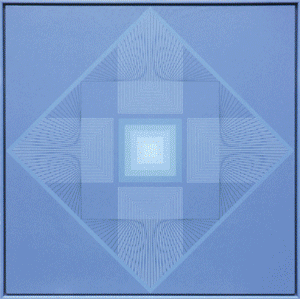- Transmission Difficulties
- Vancouver Painting in the 1960s
- A painting is a pitiable thing . . .
- The experience of a work of art . . .
- A painting is mediumistic . . .
- By Scott Watson
19.
In 1968, Morris began his last series on canvas (later, in the eighties, he returned to painting while living in Berlin). These "Letter" paintings incorporated mirrors, thus they became environmental works. In the title of the series it is clear that Morris's involvement in the correspondence network was already deepening. It was a reproduction of his Problem of Nothing (1966) in Artforum--a painting thereby returned to its source--that had led to the contact between Michael Morris and Ray Johnson.
The title appealed to Johnson, who convened regular fictional meetings he called Nothings. The title, of course, crystallized the negation that high art was trying to hang on to. The relationship between Johnson and Morris led to the foundation of Image Bank (1967-70), a collaboration that included Vincent Trasov and--for the first years, in a dazzling way--Gary Lee-Nova. Image Bank was the main Vancouver terminal of a mail artwork that operated as a staging for individual works and the monumental archiving of popular, historical and sacred imagery according to arbitrary, poetic and sociological categories. It was, in a way, the first intimation of the type of communications universe that was opening up with telecommunications (faxes), jet travel, colour television and computers--such as they were in the 1960s. Image Bank launched Colour Bar Research in 1967 and carried on the research until 1971.
Colour Bar Research was a multimedia modular environmental series of paintings, photographs, objects and films. The most ambitious of the projects was the production of hundreds of painted wooden colour bars in three series: the colours of the spectrum (rainbow), the grey scale and the individual colours of the spectrum with gradated saturation. These were then placed in natural and/or gallery environments, and photographed and filmed. Eric Metcalfe and Kate Craig's Leopard Reality Triangles (1971) is another such environmental "painting," modeled on the Colour Bar Research and demonstrating how fully "authorship" was distributed into collaboration and viewer-participant interaction. It can be argued that the colour bar projects sum up the issues that beset painting in the sixties, providing everything required by the demands of communication and reproducibility but finally rendering painting as concept.
Thus, the idea of painting became increasingly expansive . . .
In 1968, Morris began his last series on canvas (later, in the eighties, he returned to painting while living in Berlin). These "Letter" paintings incorporated mirrors, thus they became environmental works. In the title of the series it is clear that Morris's involvement in the correspondence network was already deepening. It was a reproduction of his Problem of Nothing (1966) in Artforum--a painting thereby returned to its source--that had led to the contact between Michael Morris and Ray Johnson.
The title appealed to Johnson, who convened regular fictional meetings he called Nothings. The title, of course, crystallized the negation that high art was trying to hang on to. The relationship between Johnson and Morris led to the foundation of Image Bank (1967-70), a collaboration that included Vincent Trasov and--for the first years, in a dazzling way--Gary Lee-Nova. Image Bank was the main Vancouver terminal of a mail artwork that operated as a staging for individual works and the monumental archiving of popular, historical and sacred imagery according to arbitrary, poetic and sociological categories. It was, in a way, the first intimation of the type of communications universe that was opening up with telecommunications (faxes), jet travel, colour television and computers--such as they were in the 1960s. Image Bank launched Colour Bar Research in 1967 and carried on the research until 1971.
Colour Bar Research was a multimedia modular environmental series of paintings, photographs, objects and films. The most ambitious of the projects was the production of hundreds of painted wooden colour bars in three series: the colours of the spectrum (rainbow), the grey scale and the individual colours of the spectrum with gradated saturation. These were then placed in natural and/or gallery environments, and photographed and filmed. Eric Metcalfe and Kate Craig's Leopard Reality Triangles (1971) is another such environmental "painting," modeled on the Colour Bar Research and demonstrating how fully "authorship" was distributed into collaboration and viewer-participant interaction. It can be argued that the colour bar projects sum up the issues that beset painting in the sixties, providing everything required by the demands of communication and reproducibility but finally rendering painting as concept.
Thus, the idea of painting became increasingly expansive . . .

